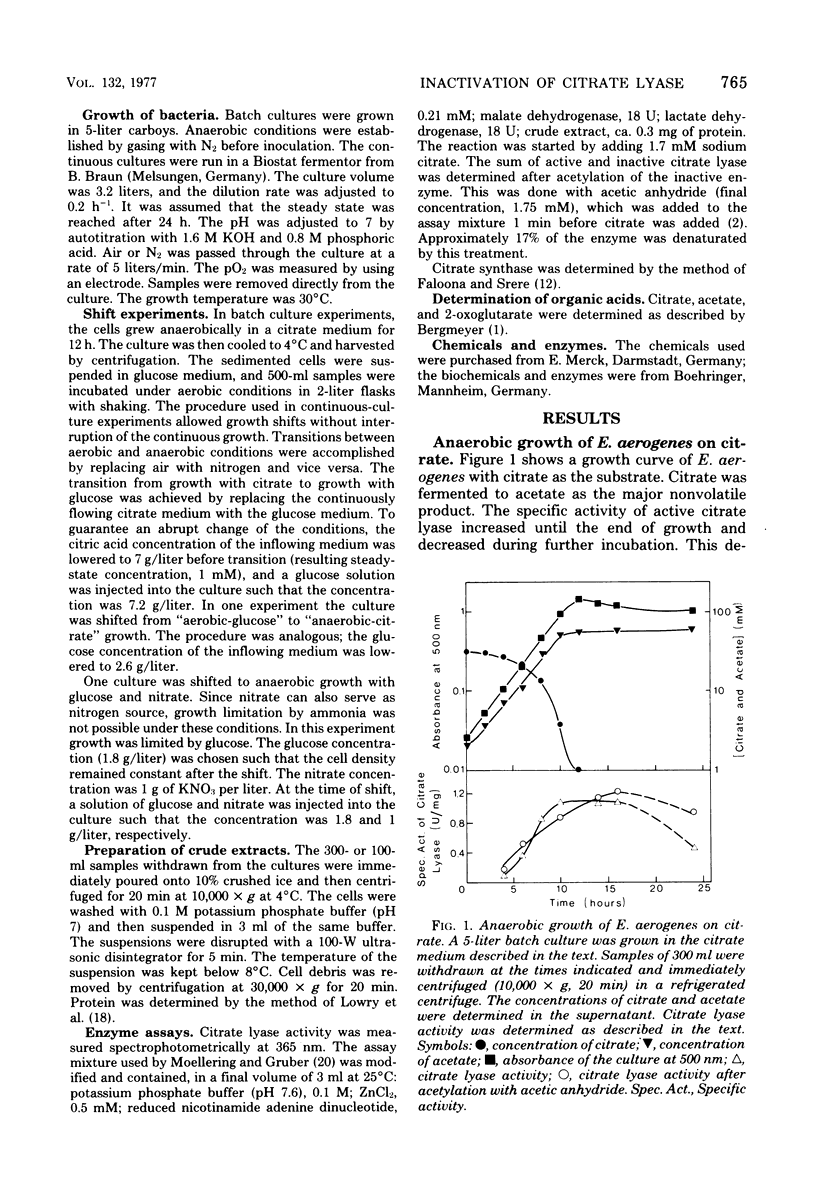Abstract
Enterobacter aerogenes was grown in continous culture with ammonia as the growth-limiting substrate, and changes in citrate lyase and citrate synthase activities were monitored after growth shifts from anaerobic growth on citrate to aerobic growth on citrate, aerobic growth on glucose, anaerobic growth on glucose, and anaerobic growth on glucose plus nitrate. Citrate lyase was inactivated during aerobic growth on glucose and during anaerobic growth with glucose plus nitrate. Inactivation did not occur during anaerobic growth on glucose, and as a result of the simultaneous presence of citrate lyase and citrate synthase, growth difficulties were observed. Citrate lyase inactivation consisted of deacetylation of the enzyme. The corresponding deacetylase could not be demonstrated in cell extracts, and it is concluded that, as in a number of other inactivations, electron transport to oxygen or nitrate was required for inactivation.
Full text
PDF






Selected References
These references are in PubMed. This may not be the complete list of references from this article.
- 't Riet J van, Stouthamer A. H., Planta R. J. Regulation of nitrate assimilation and nitrate respiration in Aerobacter aerogenes. J Bacteriol. 1968 Nov;96(5):1455–1464. doi: 10.1128/jb.96.5.1455-1464.1968. [DOI] [PMC free article] [PubMed] [Google Scholar]
- Beuscher N., Mayer F., Gottschalk G. Citrate lyase from Rhodopseudomonas gelatinosa: purification, electron microscopy and subunit structure. Arch Microbiol. 1974;100(4):307–328. doi: 10.1007/BF00446325. [DOI] [PubMed] [Google Scholar]
- Buckel W., Buschmeier V., Eggerer H. Der Wirkungsmechanismus der Citrat-Lyase aus Klebsiella aerogenes. Hoppe Seylers Z Physiol Chem. 1971 Sep;352(9):1195–1205. [PubMed] [Google Scholar]
- Campbell J. J., Gunsalus I. C. Citric Acid Fermentation by Streptococci and Lactobacilli. J Bacteriol. 1944 Jul;48(1):71–76. doi: 10.1128/jb.48.1.71-76.1944. [DOI] [PMC free article] [PubMed] [Google Scholar]
- DAGLEY S. Dissimilation of citric acid by Aerobacter aerogenes and Escherichia coli. J Gen Microbiol. 1954 Oct;11(2):218–227. doi: 10.1099/00221287-11-2-218. [DOI] [PubMed] [Google Scholar]
- De Groot G. N., Stouthamer A. H. Regulation of reductase formation in Proteus mirabilis. I. Formation of reductases and enzymes of the formic hydrogenlyase complex in the wild type and in chlorate-resistant mutants. Arch Mikrobiol. 1969;66(3):220–233. [PubMed] [Google Scholar]
- De Groot G. N., Stouthamer A. H. Regulation of reductase formation in Proteus mirabilis. II. Influence of growth with azide and of haem deficiency on nitrate reductase formation. Biochim Biophys Acta. 1970 Jun;208(3):414–427. doi: 10.1016/0304-4165(70)90214-x. [DOI] [PubMed] [Google Scholar]
- Faloona G. R., Srere P. A. Escherichia coli citrate synthase. Purification and the effect of potassium on some properties. Biochemistry. 1969 Nov;8(11):4497–4503. doi: 10.1021/bi00839a041. [DOI] [PubMed] [Google Scholar]
- Giffhorn F., Gottschalk G. Inactivation of citrate lyase from Rhodopseudomonas gelatinosa by a specific deacetylase and inhibition of this inactivation by L-(+1-glutamate. J Bacteriol. 1975 Dec;124(3):1052–1061. doi: 10.1128/jb.124.3.1052-1061.1975. [DOI] [PMC free article] [PubMed] [Google Scholar]
- Gray C. T., Wimpenny J. W., Mossman M. R. Regulation of metabolism in facultative bacteria. II. Effects of aerobiosis, anaerobiosis and nutrition on the formation of Krebs cycle enzymes in Escherichia coli. Biochim Biophys Acta. 1966 Mar 28;117(1):33–41. doi: 10.1016/0304-4165(66)90149-8. [DOI] [PubMed] [Google Scholar]
- Kümmel A., Behrens G., Gottschalk G. Citrate lyase from Streptococcus diacetilactis. Association with its acetylating enzyme. Arch Microbiol. 1975;102(2):111–116. doi: 10.1007/BF00428354. [DOI] [PubMed] [Google Scholar]
- LIN E. C., LEVIN A. P., MAGASANIK B. The effect of aerobic metabolism on the inducible glycerol dehydrogenase of Aerobacter aerogenes. J Biol Chem. 1960 Jun;235:1824–1829. [PubMed] [Google Scholar]
- LOWRY O. H., ROSEBROUGH N. J., FARR A. L., RANDALL R. J. Protein measurement with the Folin phenol reagent. J Biol Chem. 1951 Nov;193(1):265–275. [PubMed] [Google Scholar]
- MAGASANIK B. Catabolite repression. Cold Spring Harb Symp Quant Biol. 1961;26:249–256. doi: 10.1101/sqb.1961.026.01.031. [DOI] [PubMed] [Google Scholar]
- Moellering H., Gruber W. Determination of citrate with citrate lyase. Anal Biochem. 1966 Dec;17(3):369–376. doi: 10.1016/0003-2697(66)90172-2. [DOI] [PubMed] [Google Scholar]
- Neijssel O. M., Hueting S., Crabbendam K. J., Tempest D. W. Dual pathways of glycerol assimilation in Klebsiella aerogenes NCIB418: their regulation and possible functional significance. Arch Microbiol. 1975 Jun 20;104(1):83–87. doi: 10.1007/BF00447304. [DOI] [PubMed] [Google Scholar]
- Neijssel O. M., Tempest D. W. The regulation of carbohydrate metabolism in Klebsiella aerogenes NCTC 418 organisms, growing in chemostat culture. Arch Microbiol. 1975 Dec 31;106(3):251–258. doi: 10.1007/BF00446531. [DOI] [PubMed] [Google Scholar]
- Oltmann L. F., Reijnders W. N., Stouthamer A. H. The correlation between the protein composition of cytoplasmic membranes and the formation of nitrate reductase A, chlorate reductase C and tetrathionate reductase in Proteus mirabilis wild type and some cholate resistant mutants. Arch Microbiol. 1976 Dec 1;111(1-2):37–43. doi: 10.1007/BF00446547. [DOI] [PubMed] [Google Scholar]
- Payne W. J. Reduction of nitrogenous oxides by microorganisms. Bacteriol Rev. 1973 Dec;37(4):409–452. doi: 10.1128/br.37.4.409-452.1973. [DOI] [PMC free article] [PubMed] [Google Scholar]
- Schmellenkamp H., Eggerer H. Mechanism of enzymic acetylation of des-acetyl citrate lyase. Proc Natl Acad Sci U S A. 1974 May;71(5):1987–1991. doi: 10.1073/pnas.71.5.1987. [DOI] [PMC free article] [PubMed] [Google Scholar]
- Showe M. K., DeMoss J. A. Localization and regulation of synthesis of nitrate reductase in Escherichia coli. J Bacteriol. 1968 Apr;95(4):1305–1313. doi: 10.1128/jb.95.4.1305-1313.1968. [DOI] [PMC free article] [PubMed] [Google Scholar]
- Singh M., Srere P. A. The reaction inactivation of citrate lyase from Aerobacter aerogenes. J Biol Chem. 1971 Jun 25;246(12):3847–3850. [PubMed] [Google Scholar]
- Waindle L. M., Switzer R. L. Inactivation of aspartic transcarbamylase in sporulating Bacillus subtilis: demonstration of a requirement for metabolic energy. J Bacteriol. 1973 May;114(2):517–527. doi: 10.1128/jb.114.2.517-527.1973. [DOI] [PMC free article] [PubMed] [Google Scholar]
- Walther R., Hippe H., Gottschalk G. Citrate, a specific substrate for the isolation of Clostridium sphenoides. Appl Environ Microbiol. 1977 Apr;33(4):955–962. doi: 10.1128/aem.33.4.955-962.1977. [DOI] [PMC free article] [PubMed] [Google Scholar]


